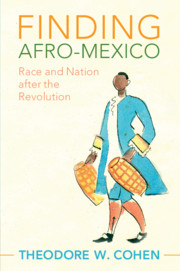Book contents
- Finding Afro-Mexico
- Afro-Latin America
- Finding Afro-Mexico
- Copyright page
- Dedication
- Contents
- Figures and Maps
- Acknowledgments
- Abbreviations
- Introduction
- Part I Making Blackness Mexican, 1810–1940s
- Part II Finding Afro-Mexico, 1940s–2015
- 4 Looking Back to Africa
- 5 Africanizing “La bamba”
- 6 Caribbean Blackness
- 7 The Black Body in Mexico
- Conclusion
- Bibliography
- Index
4 - Looking Back to Africa
from Part II - Finding Afro-Mexico, 1940s–2015
Published online by Cambridge University Press: 17 April 2020
- Finding Afro-Mexico
- Afro-Latin America
- Finding Afro-Mexico
- Copyright page
- Dedication
- Contents
- Figures and Maps
- Acknowledgments
- Abbreviations
- Introduction
- Part I Making Blackness Mexican, 1810–1940s
- Part II Finding Afro-Mexico, 1940s–2015
- 4 Looking Back to Africa
- 5 Africanizing “La bamba”
- 6 Caribbean Blackness
- 7 The Black Body in Mexico
- Conclusion
- Bibliography
- Index
Summary
Chapter 4 explores how transnational, antifascist constructions of blackness in Mexico allowed anthropologist Gonzalo Aguirre Beltrán and artist-cum-ethnographer Miguel Covarrubias to trace Mexican cultural expressions back to Africa. It shows how Mexican and Afro-diasporic politics converged during the Second World War, when Mexico transformed into an ideal site for the inter-American study of indigenous and African-descended peoples and cultures. With Mexico City as the headquarters for the International Institute of Afro-American Studies, an impressive cohort of scholars concerned with blackness in the Americas -- including W. E. B. Du Bois, Melville and Frances Herskovits, and Fernando Ortiz -- came into direct contact with Mexican social science. As other nations took inspiration from Mexico’s cultural brand of race, these Aguirre Beltrán and Covarrubias adopted the ethnographic theories and methods prevalent elsewhere used to recognize the presence of African cultural retentions, or Africanisms, in the Western Hemisphere. For the first time, ethnographic data and archival research about African slaves and their descendants from the United States, Cuba, and Brazil were relevant to Mexican history and ethnography.
Keywords
- Type
- Chapter
- Information
- Finding Afro-MexicoRace and Nation after the Revolution, pp. 119 - 153Publisher: Cambridge University PressPrint publication year: 2020



